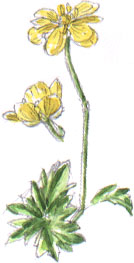 |
Creeping ButtercupFriday 3rd August 2001, West Yorkshire |
![]()
![]()
![]()
![]()
![]()
![]() This Month
Rocks
History
Workshop
Links
Home Page
This Month
Rocks
History
Workshop
Links
Home Page
![]()
 I DON'T OFTEN pick any wild flower to draw, but this Creeping Buttercup, Ranunculus repens was due for trimming back anyway, when I next cut the front lawn. As the name suggests, it spreads by creeping stems, putting down new roots every now and then, so, being a surface spreader, it isn't anything as like as bad as the Field Bindweed to eradicate, which spreads underground. Buttercups and Daisies add a touch of colour and wildlife interest to the lawn.
I DON'T OFTEN pick any wild flower to draw, but this Creeping Buttercup, Ranunculus repens was due for trimming back anyway, when I next cut the front lawn. As the name suggests, it spreads by creeping stems, putting down new roots every now and then, so, being a surface spreader, it isn't anything as like as bad as the Field Bindweed to eradicate, which spreads underground. Buttercups and Daisies add a touch of colour and wildlife interest to the lawn. Botanical keys encourage a close examination of the details of flower, stem and leaf to make a positive identification of a species but the more you get to know plants the more you realise that each has what bird watchers call a 'jizz'; a set of indefinable characteristics that, taken together, make the species as easy to spot as a friend in a crowded room.
Botanical keys encourage a close examination of the details of flower, stem and leaf to make a positive identification of a species but the more you get to know plants the more you realise that each has what bird watchers call a 'jizz'; a set of indefinable characteristics that, taken together, make the species as easy to spot as a friend in a crowded room.So the habit of creeping buttercup, which typically forms a rambling patch, makes it easy to pick out from a Meadow Buttercup, which would
 usually be taller and would be found growing individually. But that would be too vague a difference to include in a field guide. A more definite difference between the two is that the meadow buttercup has a deeply divided, I'd say almost 'hand-shaped' leaf, while the creeping buttercup (left), although similar, has a little stem within the leaf, connecting the end of the leaf to the lower part.
usually be taller and would be found growing individually. But that would be too vague a difference to include in a field guide. A more definite difference between the two is that the meadow buttercup has a deeply divided, I'd say almost 'hand-shaped' leaf, while the creeping buttercup (left), although similar, has a little stem within the leaf, connecting the end of the leaf to the lower part.Organic Forms
As I was saying the other day, there's something about any organic form, even the humble buttercup, that makes it more satisfying to draw than the flashiest man-made object - I think of a toaster as the kind of object that I have the least interest in drawing.But it's not just an artist's hunch that the form of a plant or animal hints at something deeper than surface appearance, there's a science, Ontogeny, dedicated to study of the growth of forms. Ontogenesis, according to the Shorter Oxford English Dictionary, is;
The development of the individual organism from the earliest embryonic stage to maturity. Also, the development of a particular (anatomical, behavioural, etc.) feature of an organism.
'Onto' comes from the Greek meaning 'of or pertaining to being' so Ontotheology can mean a perception of a supreme being. Mixing flowers and theology, William Blake suggested that it was possible to see 'heaven in a wildflower'. Whatever your feelings about supreme beings there's certainly a hidden world behind the appearance of any garden weed. You just need to take a closer look.
Related Link
Professor Roger Meicenheimer studies Ontogeny at Miami University, Oxford, Ohio. He's published a series of 3D microscope photographs that show the early stages of shoot growth in the Creeping Buttercup. His aim is measure and describe the growth and form of plants from their embryonic beginnings and to understand some of the processes involved.Individual cells show up clearly in the photographs, which remind me of alien creatures or termite mound landscapes. But in fact these forms are the starting points for the familiar flowers, stems and leaves of the common buttercup.
I haven't developed the knack of focusing my eyes so as to see the stereoscopic effect in the pictures, a technique that is described on the web site.
![]()
Richard Bell,
wildlife illustrator
E-mail; 'richard@willowisland.co.uk'
![]() Next page
Previous page
This day last year
This month
Nature Diary
Home Page
Next page
Previous page
This day last year
This month
Nature Diary
Home Page
![]()